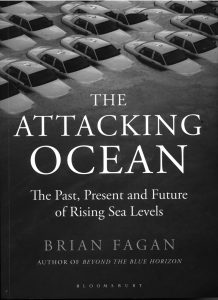- Author
- Book reviewer
- Subjects
- Book reviews
- Tags
-
- RAN Ships
- None noted.
- Publication
- December 2013 edition of the Naval Historical Review (all rights reserved)
The Attacking Ocean: The Past, Present, and future of Rising Sea Levels by Brian Fagan. Published by: Bloomsbury, London, 2013. Paperback of 266 pages with b & w charts and illustrations. rrp $29.99.

Bestselling author Brian Fagan is emeritus professor of anthropology at the University of California, Santa Barbara. His latest book The Attacking Ocean is the third in his trilogy on mankind’s relationship with the most important resource on earth: the story of the changing coastlines of the planet.
Fagan takes us back fifteen thousand years when dramatic changes in sea levels were first experienced on the Earth’s surface with rapid global warming announcing the end of the Ice Age. When ice started retreating sea levels were as much as 220 meters below modern levels. Over the next eleven millennia the oceans and seas started rising reaching near present levels about 4000 B.C.E. Because human population was relatively small and dispersed these changes had no great impact on humans other than to improve their habitat. However over the past 6000 years there has been an immense increased population. By the time of Christ at least two hundred million people lived on Earth. With the Industrial Revolution by the late 18th century this number had reached a billion. Today seven billion people are on Earth many clustered around the coastlines where any changes to sea levels are likely to have a severe impact. The author warns us that the oceans are once again warming and this is accelerated due to the impact of man on the environment.
The Attacking Ocean aims to tell a tale of past history and extrapolate this to the present and into the future and, examine the increasing complexity in the relationship between humans and the sea. The book is divided into three parts:
- ‘Millennia of Dramatic Change’ covers the period between 15000 B.C.E. and 4000 B.C.E. discussing a period of rapid sea level changes and their impact on human societies throughout Europe, the Mediterranean, Africa, Asia and America.
- ‘Catastrophic Forces’ tells the story of human vulnerability and of societies which often have a relationship with those of today.
- The book concludes with ‘Challenging Inundations’ which aims to observe the extraordinary challenges that now confront us. There is a masterful quote from Lord Byron’s Childe Harold’s Pilgrimage which of itself is a wonderful summary:
Roll on, thou deep and dark blue ocean – roll!
Ten thousand fleets sweep over thee in vain.
Man marks the earth with ruin – his control
Stops with the shore.
The author points to the problems of Bangladesh with a population of 168 million, mostly cramped into a small low lying flood prone delta. With population increasing at the same time as rising sea levels there is inevitable impact upon the amount of available land. Many millions now living close to the Bay of Bengal will have to move, producing a refugee problem on a scale not previously known. Closer to our own region, smaller islands in the Indian and Pacific Oceans, with many of these lying no more than five meters above sea level, will be affected, again producing a refugee problem likely to impact Australia and New Zealand.
This work needs careful study as it is a subject that effects us all and one on which we need to be better informed. But the work is by no means daunting and is very readable. There is a mass of information starting many thousands of years ago and progressing chronologically through to the modern era covering such events as the American Gulf Coast storms in 2005 and Asian tsunamis in 2011. There are ample diagrams and maps but some of these are inferior in reproduction when compared with the extremely high quality of the overall work. This book should appeal to all those, as the Psalms tell us, ‘who go down to the sea in ships, that do business in great waters.’ It is the culmination of years of research into climate change which is amply supported by numerous notes relating to sources used in various chapters, and there is a comprehensive index.
Reviewed by Tony Maskell




